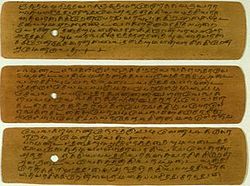
Palm leaf manuscript
Encyclopedia

Manuscript
A manuscript or handwrite is written information that has been manually created by someone or some people, such as a hand-written letter, as opposed to being printed or reproduced some other way...
s made out of dried palm leaves. They served as the paper of the ancient world in parts of Asia as far back as the fifteenth century BCE. and possibly much earlier. They were used to record actual and mythical narratives in South Asia
South Asia
South Asia, also known as Southern Asia, is the southern region of the Asian continent, which comprises the sub-Himalayan countries and, for some authorities , also includes the adjoining countries to the west and the east...
and in South East Asia. Initially knowledge was passed down orally, but after the invention of alphabets and their diffusion throughout South Asia
South Asia
South Asia, also known as Southern Asia, is the southern region of the Asian continent, which comprises the sub-Himalayan countries and, for some authorities , also includes the adjoining countries to the west and the east...
, people eventually began to write it down in dried and smoke treated palm leaves of Palmyra palm or talipot palm
Talipot palm
Corypha umbraculifera is a species of palm, native to southern India and Sri Lanka.It is one of the largest palms in the world; individual specimens have reached heights of up to 25 m, with stems up to 1.3 m in diameter...
.
Once written down, each document had a limited time before which the document had to be copied onto new sets of dried palm leaves. With the spreading of Indian culture to South East Asian countries such as Thailand
Thailand
Thailand , officially the Kingdom of Thailand , formerly known as Siam , is a country located at the centre of the Indochina peninsula and Southeast Asia. It is bordered to the north by Burma and Laos, to the east by Laos and Cambodia, to the south by the Gulf of Thailand and Malaysia, and to the...
, Cambodia
Cambodia
Cambodia , officially known as the Kingdom of Cambodia, is a country located in the southern portion of the Indochina Peninsula in Southeast Asia...
and Indonesia
Indonesia
Indonesia , officially the Republic of Indonesia , is a country in Southeast Asia and Oceania. Indonesia is an archipelago comprising approximately 13,000 islands. It has 33 provinces with over 238 million people, and is the world's fourth most populous country. Indonesia is a republic, with an...
, these nations became home to collections of documents in palm leaf. In Indonesia the palm-leaf manuscript is called lontar. With the introduction of printing presses in the early 19th century this cycle of copying from palm leaves came to an end. Many governments are making efforts to preserve what is left of their palm leaf documents.
In 1997 The United Nations Educational Scientific and Cultural Organisation (UNESCO
UNESCO
The United Nations Educational, Scientific and Cultural Organization is a specialized agency of the United Nations...
) recognised the Tamil Medical Manuscript Collection as part of the Memory of the World Register.
A very good example of usage of Palm leaf manuscripts to store the history is a Tamil grammar book named Tolkāppiyam
Tolkappiyam
The Tolkāppiyam is a work on the grammar of the Tamil language and the earliest extant work of Tamil literature. It is written in the form of noorpaa or short formulaic compositions and comprises three books - the Ezhuttadikaram, the Solladikaram and the Poruladikaram. Each of these books is...
is written during 4th B.C.

